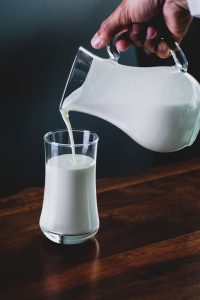March 16, 2020
(Note: Please pay attention to news and other current sources cited in the resource sheet associated with this article. Conditions are changing rapidly.)
Authors:
- Mark Stephenson, Director of Dairy Policy Analysis and Director of the Center for Dairy Profitability, College of Agricultural and Life Sciences and Division of Extension, University of Wisconsin-Madison
- John Shutske, Extension Specialist, Biological Systems Engineering and Director of the UW Center for Agricultural Safety and Health, University of Wisconsin-Madison
The World Health Organization now considers the novel coronavirus (COVID-19) to be a pandemic. The rapidly evolving situation is raising questions throughout the U.S. The stock market has taken a hit in recent weeks creating wild volatility and there are growing concerns about the virus and our reaction to it causing a significant downturn in the general economy.
But, what about agriculture? Here are six specific things that farmers, farming families, ag employers, and employees need to be aware of and plan for.
1. Markets and farm prices: As we see growing levels of concern, recommendations for “social distancing,” reduced travel, avoiding crowds, closures, and other protective practices to slow the spread of COVID-19, consumers  will be making tough choices about food, eating away from home, and overall spending. Dairy is prominently featured in out-of-home eating and there may be some disruptions in food service sales. This will likely have an impact on markets and prices. There have also been bottlenecks at ports in other countries as ships wait to be offloaded with U.S. dairy and other farm products. The Chicago Mercantile Exchange has shut down floor trading of all products until “further notice,” though electronic trading will continue.
will be making tough choices about food, eating away from home, and overall spending. Dairy is prominently featured in out-of-home eating and there may be some disruptions in food service sales. This will likely have an impact on markets and prices. There have also been bottlenecks at ports in other countries as ships wait to be offloaded with U.S. dairy and other farm products. The Chicago Mercantile Exchange has shut down floor trading of all products until “further notice,” though electronic trading will continue.
Concerns about the impact of the virus on the broader economy are likely to have an even larger impact on dairy prices. Many countries of the European Union were already hovering just above a recession prior to the viral outbreak and this event is likely to push them over the edge. Prior to this event, China was also experiencing slower economic growth. The U.S. has enjoyed strength in the economy, but there have been leading indicators prior to pandemic concerns that suggested that we were past the peak of the business cycle and that an economic slowdown, or perhaps that a recession was coming. A worldwide recession, like the one experienced in 2008-09, would push the previously expected milk price recovery off for at least another year.
2. Supply chains slowdowns and shortages: As logistics are disrupted and efforts proceed to slow the spread of the virus, multiple connected industry sectors are already being impacted. With some products, “panic buying” is creating additional concern. As an example of supply chain interruptions on farms, the American Veterinary Medical Association (AVMA) suggests the potential for animal pharmaceutical products to be in short supply for at least some of the larger drug manufacturers. If the virus were to spread more broadly in an agricultural state like Wisconsin, we could see issues with farm product delivery and pickup as workers – milk truck drivers for example – stay home due to illness or because they are caring for family members or school-age children. These same concerns would affect processors. Slowdowns could also impact fertilizer, fuel and other input movement and availability as we head toward spring. In an extreme case, we could have concerns with utilities – electricity, natural gas, propane – based on input availability or labor shortages. However, utility companies generally do a good job of contingency planning which helps buffer the impact of unforeseen events.
2. Farmers’ health: Throughout the Midwest, farmers are a relatively older population, as compared to the general worker population. The 2017 ag census shows the average age of farm operators to be almost 58 – at least a full ten years older than workers in most other sectors. And, unlike other industry workers, farm operators, 26% are age 65 years and up. A full 11.7% of our principal farm operators are age 75 and older. Data from other countries that have done more extensive testing suggest that COVID-19 has a much higher level of severity for those in their 60s and older, meaning that preventive and protective recommendations from the CDC and state (and local) public health experts are critical for our farming population.
3. The farm workforce: Even if the general population infection rate remains relatively low, it is likely that we will see some workers who end up sick. But, perhaps more importantly, even if the infection rate stays low (single digits), it is highly likely that workers will need to be out of work particularly with school closures and/or workers who need to stay home to care for sick or elderly family members. The fear of this event and lack of information may also lead to higher levels of absenteeism.
4. Worker safety and Personal Protective Equipment (PPE): There are shortages of PPE and other protective equipment vital for operating a farm safely and keeping workers and animals healthy. As a result of the current demands by the healthcare industry, N-95 respirator supplies are highly limited (likely to be needed this spring for handling dusty grain as a result of last fall’s sub-optimal harvest conditions). There are also reported concerns about availability of protective gloves which have now become commonplace in dairy operations as a protective means to improve milk quality and protect the health of animals and people.
 5. Other Disruptions: Sparse populations and less frequent travel may provide a natural social distancing for rural communities but there are challenges that may be faced by rural residents. Many gathering places, such as schools and churches, are being closed and told to halt normal routines and events. As a substitute, in some areas and for high school and college students, classes and services are being taught online. This may be difficult for some rural residents as high-speed internet service is not available in some areas of the state including some of our communities with a strong agricultural base.
5. Other Disruptions: Sparse populations and less frequent travel may provide a natural social distancing for rural communities but there are challenges that may be faced by rural residents. Many gathering places, such as schools and churches, are being closed and told to halt normal routines and events. As a substitute, in some areas and for high school and college students, classes and services are being taught online. This may be difficult for some rural residents as high-speed internet service is not available in some areas of the state including some of our communities with a strong agricultural base.
Only time will reveal the severity of the impacts on agriculture from the novel coronavirus. We urge everyone to take reasonable precautions to limit the spread of the disease and its influence on your businesses and lives. Hoarding of farm supplies is not recommended and could cause even greater problems for the sector, but prudent purchases of necessary inputs might minimize disruptions to your business. Please keep informed, listen to the experts, and follow the recommendations of federal, state and local agencies and authorities. The next page of this document will be updated as needed and as additional resources become available to help farmers and other rural communities prepare for and respond to the COVID-19 virus and its impacts.
Preparedness for Agriculture Business Disaster & Defense
Based on original work of UW-Extension Farm Management Program Manager Trisha Wagner
Last updated: March 16, 2020
In the case of the current COVID-19 public health situation, there will almost inevitably be unexpected consequences as farm and other supplies become limited or unavailable. A farm business continuity plan will help farmer operators and businesses to pinpoint contingencies in critical areas related to employees/staff and could include backup plans for work practices, transportation, communication, service, and supply chain, and cash flow. Farms should involve suppliers, and customers where appropriate, in developing these plans. In many cases, input suppliers, processors, cooperatives and other stakeholders are updating their plans and information daily. Make sure to subscribe to updates from key information sources (via email or other means) and check websites frequently for updates on their current status. Farms may consider running outage “exercises” and walking through what-if scenarios to assess the possibility of unforeseen impacts. Even after we have gotten through these challenging times here in early 2020, a farm business continuity and preparedness plan has great value and can help you think through other types of unforeseen events in the future.
Suggested Resources for Farmers and Others:
Epidemic Preparedness for Community Organizations – A resource for organizational/business preparedness specific to epidemics (factsheets, templates and online course) by the Extension Disaster Education Network.
Get Your Workplace Ready for Pandemic Flu (AND OTHER types of infectious illness including COVID-19) – A workbook (set of factsheets), on workplace preparedness for flu pandemic by the Center for Disease Control
ReadyAg Workbook – A detailed planning guide to help farmers better prepare for general disasters.
Ready Business – A general business preparedness planning resource, by the Federal Emergency Management Agency/Dept. of Homeland Security.
If you have questions related to the above resources or farm-level preparedness and planning, please contact John Shutske (john.shutske@wisc.edu) or Cheryl Skjolaas (skjolaas@wisc.edu) with UW Center for Agricultural Safety and Health.
Additional Public Resources for self-care, personal health, and making decisions for yourself, family members and others:
The Centers for Disease Control (CDC), Wisconsin Department of Health Services (DHS), and local health departments have compiled information for the general public to learn more about COVID-19. As Extension educators, we can provide support to these agencies by amplifying important messages and critical information and by referring the public back to these public health agencies.
- Current coronavirus – COVID-19 situation statement (CDC)
- Find general information about COVID-19 including protective measures (CDC)
- Find Wisconsin-specific information about COVID-19 including fact sheets in English, Chinese, Spanish, Hmong (DHS)




